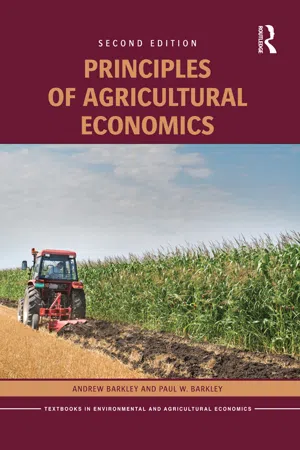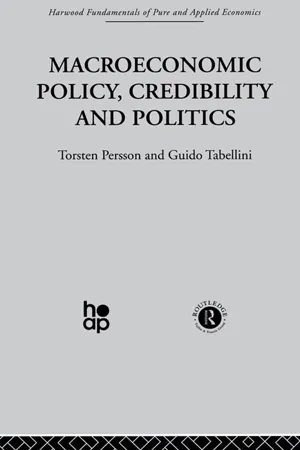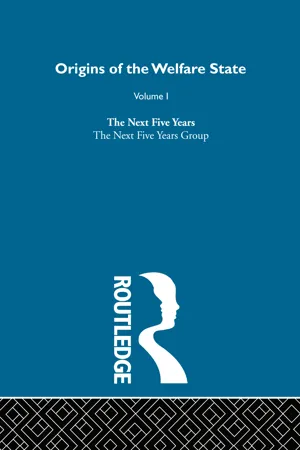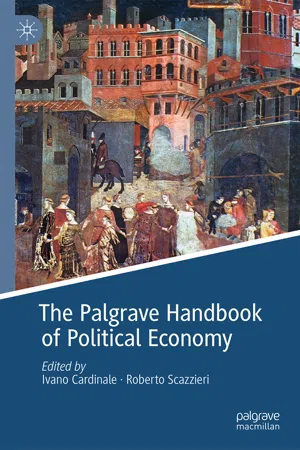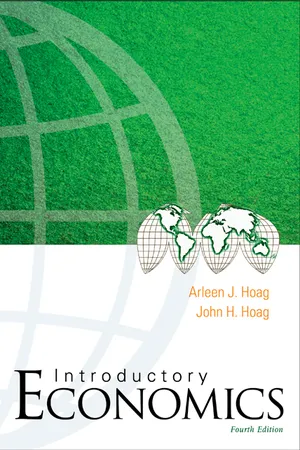Economics
Economic policy
Economic policy refers to the actions and measures implemented by governments to influence the economy. It encompasses decisions related to taxation, government spending, monetary policy, and regulation. The primary goal of economic policy is to achieve sustainable economic growth, price stability, and full employment.
Written by Perlego with AI-assistance
Related key terms
Related key terms
1 of 4
Related key terms
1 of 3
6 Key excerpts on "Economic policy"
- eBook - ePub
- Andrew Barkley, Paul W. Barkley(Authors)
- 2016(Publication Date)
- Routledge(Publisher)
ceteris paribus . Given the huge range of other economic activities occurring in an economy, including international trade, technological change, and income growth, monetary policy is a crude instrument. Particularly vexing to the monetary authority is the time lag between when monetary policies are conducted and changes in economy-wide activities. Given the huge size of the economy, it takes time for monetary policy to work.11.3.5 Fiscal policy
Fiscal policy is the second type of macroEconomic policy.- Fiscal Policy = attempts by a government to influence macroeconomic variables through taxes and government spending.
Fiscal policy is heavily debated: there is a great deal of disagreement among economists about the most appropriate form of fiscal policy. Expansionary fiscal policy is employed during times of recession: the government will increase government spending and/or lower tax rates with the goal of spurring economic growth. Restrictive fiscal policy involves reducing government spending and/or increasing taxes to reduce economic activity.The legislative branch of government typically appropriates money for government expenditures and sets tax rates. In the US, Congress has authority for fiscal policies. The goals of fiscal policy are identical to those of monetary policy: to reduce or eliminate fluctuations in business cycles, keep inflation low and steady, and promote economic growth. However, the policy instruments differ substantially: fiscal policy uses tax rates on individuals and corporations to expand or contract economic activity. The main idea is that if households and firms are able to keep more of their earnings, they will spend the retained earnings and have an incentive to earn more. Thus, the economy can be stimulated through lower tax rates. Similarly, government expenditures can be used to induce higher levels of economic activity. - eBook - ePub
- T. Persson, G. Tabellini(Authors)
- 2012(Publication Date)
- Routledge(Publisher)
MacroEconomic policy, Credibility and Politics Torsten PerssonInstitute for International Economic Studies, Stockholm, SwedenGuido TabelliniDepartment of Economics, University of California, Los Angeles, USA1. Economic policy as a Game1.1. IntroductionUntil very recently, the theory of macroEconomic policy dealt with the economic consequences of given policy rules. Knowing these consequences and the policy objectives, one would then select the optimal policy rule. Implicit in this approach to policy design is a particular view of the policymaker, namely that he is a passive agent that can be programmed like a machine. Once the optimal rule is identified, the policymaker implements it and the private sector adapts to it.This approach to the analysis of Economic policy contrasts sharply with the way in which policy is carried out in practice. The policymaker is typically a rational and maximizing agent, or collection of agents, who respond to incentives and constraints just like the rest of the economy. A theory of Economic policy that neglects these incentives in policy formation is incomplete and is bound to yield misleading prescriptions. For this reason, the recent literature on the theory of Economic policy has changed focus. At the core of the research program—together with the study of the consequences of alternative policy rules—is now the analysis of the policy formation process.At an abstract level, the new approach can be described as the analysis of a principal-agent problem, with many principals and possibly more than one agent. The individual citizens are the principals. They operate as political as well as economic actors. In their political role, they delegate the formulation of Economic policy to an agent (or to several agents), the policymakers(s). The agent in turn selects a policy that maximizes his objectives, subject to the relevant constraints. These constraints include the private economic responses to the policy that the principals choose in their role as economic actors. The normative problem is how to design such incentives that the agent implements a policy that maximizes the collective interests of the principals. - eBook - ePub
- Nicholas Deakin(Author)
- 2021(Publication Date)
- Routledge(Publisher)
Economic policy DOI:9781003101574-2Passage contains an image
CHAPTER I ECONOMIC PLANNING
DOI:9781003101574-3WE turn first to questions of Economic policy; for in the period in which we live, the main substance of public policy will generally be determined by economic needs.We approach the subject from the standpoint indicated in the Introduction. We recognize that deep differences of interest and opinion exist as to the ultimate goal of economic and social policy; but we believe that there are enough who agree upon the kind of policy required in the immediate future and upon the need for a coherently planned policy, to afford adequate support for such a programme as we shall try to formulate.THE NEED FOR ECONOMIC PLANNING
It is evident that the present economic system is in many respects very unsatisfactory. The community has not yet discovered methods by which production can be allowed to expand to full capacity and by which the resources of the nation can be fully employed to enrich man’s life and endow his leisure.The motive of profit-making has already, to a greater extent than is commonly realized, ceased to be the mainspring of economic activity in this country: and we think it safe to assume that this tendency will continue in the future, and that the principle of developing the resources available to the community under public ownership or control for the use of the whole community will be further extended in the years immediately ahead.Apart from the question of motive, we believe that the State will find it increasingly necessary to intervene in order to set the direction - eBook - ePub
Bucking The Deficit
Economic Policymaking In America
- G Calvin Mackenzie, Saranna Thornton(Authors)
- 2018(Publication Date)
- Routledge(Publisher)
This is not to say that monetary policy decisions are the result of careful political calculations and compromises, as fiscal policy decisions often are. They are constrained by political realities in a broader sense. In fact, the Fed sometimes takes actions that anger presidents and members of Congress and becomes a scapegoat for politicians unhappy about economic conditions.Charles L. Schultze, an economist who served as Lyndon Johnson’s budget director and chair of Jimmy Carter’s Council of Economic Advisers, has written, “In a pragmatic way, the Federal Reserve typically acts to reduce the chances of making serious mistakes by practicing a policy of ‘leaning against the wind’” (Schultze, 1992: p. 187). When the economy seems to be expanding too rapidly or when the dangers of inflation rise, the Fed tends to tighten the money supply. When the economy is in recession, it may do the opposite. The Fed most often seeks economic stability by using monetary policy to counter other forces that seem to be destabilizing.MicroEconomic policy
When it develops and implements fiscal or monetary policy, the federal government generally seeks to use its available instruments to bring about economic growth and prosperity. The focus is broad and the impacts are felt throughout much of the American economy. At other times, however, national policymakers initiate actions designed to affect a much narrower slice of the economy, often a single industry, sometimes a single company. We earlier described broad policy initiatives in fiscal and monetary policy as macroEconomic policy. These narrower undertakings are microEconomic policy.Even though their focus is narrow, microeconomic policies sometimes have ripple effects through the entire economy. When the price of an important commodity such as natural gas is regulated at lower-than-market levels, for example, a wide spectrum of industries and consumers are able to operate less expensively than they could in the absence of regulation. That might allow industries to invest more and consumers to save more. It would encourage both to select natural gas as their fuel of choice rather than oil, coal, or some other fuel, thus affecting other fuel industries. - eBook - ePub
- Ivano Cardinale, Roberto Scazzieri, Ivano Cardinale, Roberto Scazzieri(Authors)
- 2018(Publication Date)
- Palgrave Macmillan(Publisher)
As Atkinson and Stiglitz (1980, p. 298) wrote it, ‘if everyone had identical tastes and endowments, then many public finance questions would lose their significance, and this is particularly true of the behavior of the state. If the interests of the members of society could be treated as those of a ‘representative’ individual, then the role of the state would be reduced to that of efficiently carrying out agreed decisions’. Social and economic differentiation breeds conflict among interests and the divergence on what a ‘good’ policy is. Most Economic policy decisions, be it decisions concerning monetary or fiscal policy or more ‘structural’ policy decisions such as financial regulation, product market competition and public ownership, or employment protection legislation, have distributional consequences: distribution of income, wealth or power, or the allocation of risks and protection. Therefore, Economic policy involves by necessity a conflict of interests. 4 It is, by nature, political. This political nature of Economic policy is not always fully taken into account by what is commonly called ‘political economics’. 5 In some models, the government is supposed to have an objective function with macroeconomic variables such as the inflation and unemployment rates as arguments. The rationale is that these arguments matter for all voters, and that the task of the government is to find a suitable policy choice in order to maximise the universal objective function. This supposes that there exists a specific definition of collective well-being in terms of macroeconomic variables. In other models, the problem that voters face is a lack of information on the competence of the government - eBook - ePub
- Arleen J Hoag, John H Hoag(Authors)
- 2006(Publication Date)
- WSPC(Publisher)
Chapter 29Economic policyKey Topics economic goals Phillips curve and stagnation policy failure other schools of thought goal trade-offs Goals re-examine macro goals and potential policies recognize that under stagnation, traditional policies may fail examine other schools of economic thought realize that policy has an opportunity costAs an evolving science, economics has generated various schools of thought. There is a controversy within economics as to which policy tools are capable of regulating the business cycle. The public is concerned with the policy choices since the public is so vitally affected by the outcome of these controversies. Our purpose here is to clarify some of the issues and present an overview of the policy choices available. We have discussed the major tools of stabilization policy, fiscal and monetary policy, at length. We have also indicated various shortcomings of these tools. There are those who believe that the basic philosophies of fiscal and monetary policy are in error and recommend reforms in our approach to stabilization policy.Policy starts with goals. Before we can decide what tools to use and how to use them, we must decide what goals to achieve. We begin this chapter with a discussion of alternative goals that might be chosen for an economy. Next we will introduce a problem of the modern economy, stagflation. We will then discuss the impact of monetary and fiscal policy on stagflation. We will briefly review classical and Keynesian economics. We next investigate some alternative approaches to policy, including monetarism, supply-side economics, and rational expectations. Our exclusion of any economic philosophy by no means indicates a lack of merit, only that we lack space for a complete review of current philosophies. We do not seek to recommend or condemn any approach to the business cycle but to summarize the rational for the alternatives. Finally, we return to the general problem of policy choice and observe that goals do trade off.
Index pages curate the most relevant extracts from our library of academic textbooks. They’ve been created using an in-house natural language model (NLM), each adding context and meaning to key research topics.
Explore more topic indexes
Explore more topic indexes
1 of 6
Explore more topic indexes
1 of 4
